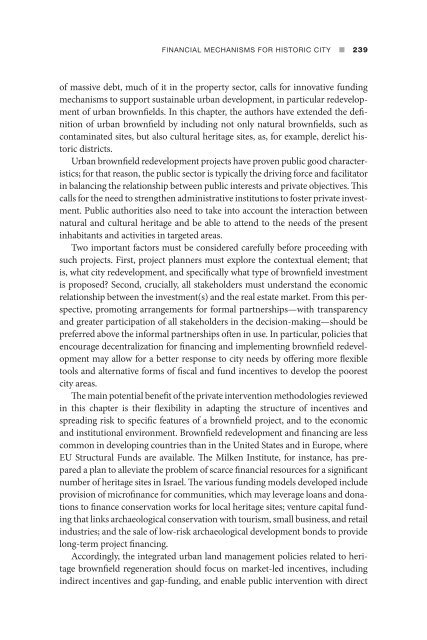ECONOMICS UNIQUENESS
ECONOMICS UNIQUENESS
ECONOMICS UNIQUENESS
Create successful ePaper yourself
Turn your PDF publications into a flip-book with our unique Google optimized e-Paper software.
FINANCIAL MECHANISMS FOR HISTORIC CITY ■ 239<br />
of massive debt, much of it in the property sector, calls for innovative funding<br />
mechanisms to support sustainable urban development, in particular redevelopment<br />
of urban brownfi elds. In this chapter, the authors have extended the defi -<br />
nition of urban brownfi eld by including not only natural brownfi elds, such as<br />
contaminated sites, but also cultural heritage sites, as, for example, derelict historic<br />
districts.<br />
Urban brownfi eld redevelopment projects have proven public good characteristics;<br />
for that reason, the public sector is typically the driving force and facilitator<br />
in balancing the relationship between public interests and private objectives. Th is<br />
calls for the need to strengthen administrative institutions to foster private investment.<br />
Public authorities also need to take into account the interaction between<br />
natural and cultural heritage and be able to attend to the needs of the present<br />
inhabitants and activities in targeted areas.<br />
Two important factors must be considered carefully before proceeding with<br />
such projects. First, project planners must explore the contextual element; that<br />
is, what city redevelopment, and specifi cally what type of brownfi eld investment<br />
is proposed? Second, crucially, all stakeholders must understand the economic<br />
relationship between the investment(s) and the real estate market. From this perspective,<br />
promoting arrangements for formal partnerships—with transparency<br />
and greater participation of all stakeholders in the decision-making—should be<br />
preferred above the informal partnerships oft en in use. In particular, policies that<br />
encourage decentralization for fi nancing and implementing brownfi eld redevelopment<br />
may allow for a better response to city needs by off ering more fl exible<br />
tools and alternative forms of fi scal and fund incentives to develop the poorest<br />
city areas.<br />
Th e main potential benefi t of the private intervention methodologies reviewed<br />
in this chapter is their fl exibility in adapting the structure of incentives and<br />
spreading risk to specifi c features of a brownfi eld project, and to the economic<br />
and institutional environment. Brownfi eld redevelopment and fi nancing are less<br />
common in developing countries than in the United States and in Europe, where<br />
EU Structural Funds are available. Th e Milken Institute, for instance, has prepared<br />
a plan to alleviate the problem of scarce fi nancial resources for a signifi cant<br />
number of heritage sites in Israel. Th e various funding models developed include<br />
provision of microfi nance for communities, which may leverage loans and donations<br />
to fi nance conservation works for local heritage sites; venture capital funding<br />
that links archaeological conservation with tourism, small business, and retail<br />
industries; and the sale of low-risk archaeological development bonds to provide<br />
long-term project fi nancing.<br />
Accordingly, the integrated urban land management policies related to heritage<br />
brownfi eld regeneration should focus on market-led incentives, including<br />
indirect incentives and gap-funding, and enable public intervention with direct


